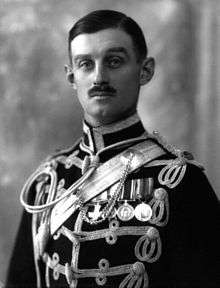Denzil Fortescue, 6th Earl Fortescue
| The Right Honourable The Earl of Fortescue | |
|---|---|
 | |
| Birth name | Denzil George Fortescue |
| Born |
13 June 1893 Castle Hill, Devon, England |
| Died |
1 June 1977 (aged 83) Ebrington, Gloucestershire |
| Allegiance |
|
| Service/branch |
|
| Years of service |
1915–1918 1939–1944 |
| Rank | Lieutenant colonel |
| Commands held | Royal Devon Yeomanry; 1st Heavy Regiment, Royal Artillery |
| Battles/wars |
First World War Second World War |
| Awards | Military Cross |
Denzil George Fortescue, 6th Earl Fortescue MC TD (13 June 1893 – 1 June 1977) was a British peer and farmer who served in both the First World War and Second World War.
Early life and education
Fortescue was the third born and second surviving son of Hugh Fortescue, 4th Earl Fortescue and Hon. Emily Ormsby-Gore, daughter of William Ormsby-Gore, 2nd Baron Harlech.[1] He grew up at the family estate at Castle Hill, North Devon. He was educated at Eton and New College, Oxford, where he studied under William Archibald Spooner.[2] He received the Military Cross in 1919:[3]
Career
He joined the Royal North Devon Yeomanry and in 1915 was sent to Gallipoli. After suffering a severe bout of dysentery, he returned home to recover. He rejoined the war in 1916 in France, where he fought at the Battle of the Somme. In four weeks, he fought in six battles.[2]
| “ | For conspicuous gallantry and devotion to duty during operations at Forest and Preux-au-Bois on 25th October and 4th November, 1918. He rode forward amongst the attacking troops for the purpose of gaining firsthand knowledge of the situation at a critical period of the battle, and sent back information of the greatest value. | ” | |
| — Citation in The London Gazette, 9 December 1919[4] | |||
Fortescue was commanding officer of the Royal Devon Yeomanry 1935-1941, and commanding officer of the 1st Heavy Regiment, Royal Artillery, 1942-1944.[2]
In 1958, he succeeded to the Earldom on the death of his older brother, Hugh Fortescue, 5th Earl Fortescue, whose only son, Hugh, Viscount Ebrington had been killed at El Alamein in 1942. He became a "regular attender and occasional speaker at the House of Lords."[2]
He lived at the family seat, Ebrington Manor, where he became a successful fruit farmer.[2]
Marriages and children
He married, firstly, Marjorie Ellinor Trotter, the granddaughter of John Hamilton, 1st Baron Hamilton of Dalzell, on 10 June 1920 and they were divorced in 1941. They had three children:
- Richard, Viscount Ebrington (1922–1993), father of the 8th Earl (by the first of his three marriages), who had three daughters. He also had three daughters, two by his second wife.
- Hon. Martin Fortescue (b. 5 January 1924; d. 2005) heir presumptive to the earldom 1977-2005, married Prudence Rowley, daughter of Sir Charles Rowley, 6th Baronet and had issue, two sons and two daughters. The elder son John Fortescue (b. 1954) is married with two sons and a daughter, and is heir presumptive to the earldom.
- Bridget Ellinor Fortescue (b. 17 October 1927), married Gordon Sinclair and had issue.
Fortescue married, secondly, Hon. Sybil Hardinge, daughter of Henry Hardinge, 3rd Viscount Hardinge, on 8 August 1941. They had one son:
- Hon. Seymour Henry Fortescue (b. 28 May 1942), married firstly, Julie Pitcher and had issue, one son and a daughter Marissa Clare (married to German Prince Maximilian zu Bentheim-Tecklenburg). He married secondly, Jennifer Simon and had issue.
Death
The sixth earl died 1 June 1977, just shy of his 84th birthday. A monument was erected in his honour at St Eadburgha's Church in Ebrington.[5]
References
- ↑ Debrett's Peerage, Baronetage, Knightage, and Companionage. London: Dean & Son, Limited. 1902. p. 343.
- 1 2 3 4 5 "Earl Fortescue: War service and fruit farming". The Times. The Times Digital Archive. 8 June 1977. p. 16.
- ↑ The London Gazette: (Supplement) no. 31266. p. 4327. 1 April 1919.
- ↑ The London Gazette: (Supplement) no. 31680. p. 15333. 9 December 1919.
- ↑ Raffield, Paul (2010). Shakespeare's Imaginary Constitution: Late Elizabethan Politics and the Theatre of Law. Bloomsbury Publishing. p. 162. ISBN 1-84731-606-9.
External links
- Hansard 1803–2005: contributions in Parliament by the Earl Fortescue
| Peerage of Great Britain | ||
|---|---|---|
| Preceded by Hugh William Fortescue |
Earl Fortescue 1958–1977 |
Succeeded by Richard Archibald Fortescue |